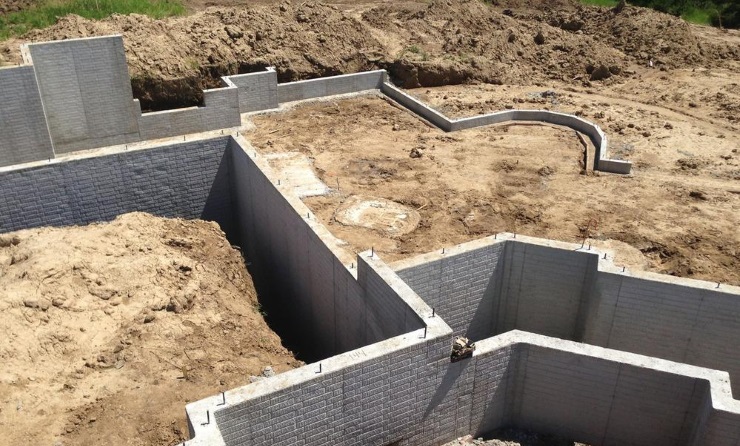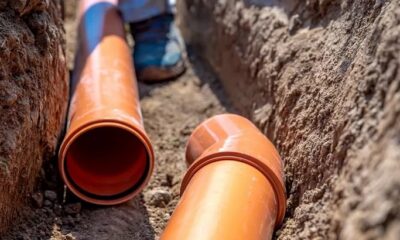Features
Different Types of Foundation and their Uses
Everything to know about building foundations.

Foundation is the invisible part of a building, which is in direct contact with the soil, and which is designed to safely transfer the weight of the house to the soil.
Here are the main types of foundation and their uses:
Foundations for building constructions are mainly classified as shallow or deep foundation, based on their specific characteristics, with each of these two types of foundation having several subcategories as follows:
1. Shallow foundations
What are types of shallow foundation?
There are four types of shallow foundation, including individual footing or isolated footing; spread footings (strip footings) and wall footings; raft or mat foundation; and combined footing.
- Individual footing or isolated footing
This is by far the most common type of foundation for buildings.
As the name suggests, individual footing (also called pad foundation) is prepared for a single column when the weight from the structure is carried by the columns.
Isolated footing can be square or rectangle. They are often used for shallow foundations to carry and spread concentrated loads caused by columns or pillars.
The size of the individual footing depends on the size of the column and the safe bearing capacity of the soil beneath.
RELATED: How to Build a Concrete Foundation
For a column with a vertical load of 200kN and a safe bearing capacity of 100kN/ m2, the required footing area will be 200/100 = 2m2.
Accordingly, the length and width of the footing will be 1.414 m x 1.414 m.
- Spread footings and wall footings
Spread footings (strip footings) have a wider than usual load-bearing wall foundation. By having a wider base, they are able to spread the weight from the structure across a wider area thus providing better stability.
Spread and wall footings are used for individual columns and walls in areas whose bearing soil layer is within 3 meters from the surface.
These types of foundation should be avoided in areas with a likelihood of a ground flow of water above the bearing soil as this may lead to scour or liquefaction.
- Raft or mat foundations
These types of foundation are spread across the total area of a building to support heavy structural weights from columns and walls.
Mat foundation is used for columns and walls foundations where the weights on the buildings on columns and walls are extremely high.
It is used to stop differential treatment of individual footings, and is designed as a single mat (or combined footing) of all the load-bearing elements of the building.
Mat foundation is idea for expansive soils that do not have enough bearing capacity to support spread footings and wall footings.
Raft foundation is a great cost-cutting option where one-half area of the building is covered with isolated footings, and wall footings have been put in place.
These types of foundation should be avoided where the groundwater table is above the bearing surface of the soil as this may result in scour or liquefaction.
- Combined footing
Combined footing is used when two or more columns are located too close to each other that their isolated footings overlap.
The rectangular footing is a union of isolated footings, but their structural design varies. It is used when weight from the structure is supported by the columns.
2. Deep Foundation
What are types of deep foundation?
There are two types of deep foundation, namely pile foundation and drilled shafts or caissons foundation.
- Pile foundation
Pile foundation is used to transfer heavy weights from the structure to a hard rock strata located too deep below the ground surface.
It resists the weights from the structure by skin friction and by end bearing. The use of pile foundations also averts differential settlement of foundations.
Pile foundations are used in areas where mat or spread footings cannot be used – areas with hard rock strata of 5 metres to 50 metres below the ground level.
- Drilled shafts or caisson foundation
Drilled shafts, also known as caisson foundation, operate the same as pile foundation except that they are high-capacity cast-in-situ foundations.
They are designed to transfer heavier weights than pile foundations.
Drilled shafts battle weights from the structure through shaft resistance, toe resistance and/or a mixture both options.
RELATED: Concrete Footings Vs. Concrete Foundation
They are used in areas where depth of hard strata is 10 meters to 100 meters below the ground level. The shafts are usually created using an auger.
Drilled shafts should be avoided in areas with deep deposits of soft clays and where loose water-bearing granular soils are present.
They are also unsuitable for soil made up huge rocks, and areas where caving formations are difficult to stabilize, and sites with artesian aquifer.












